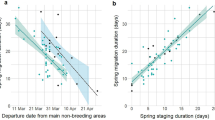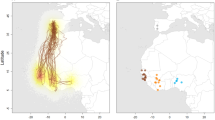Abstract
For successful breeding, good timing is of the utmost importance for birds inhabiting seasonal environments. Seasonal declines in reproductive success have been well documented in birds (e.g. Perrins 1970; Verhulst et al. 1995) and shown to be causally related to the timing of breeding (e.g. Verhulst et al. 1995; Brinkhof and Cave 1997). For arctic breeders the window in which breeding can take place is even narrower. Therefore, the capacity of migratory birds to fit both their breeding season and preparations for return migration to southern latitudes into the short arctic summer has provided a long-standing riddle. Because of this constraint and the apparent lack of feeding opportunity on the breeding grounds upon arrival, many researchers have deemed the importance of postmigratory residual body stores for successful breeding (e.g. Ryder 1970; Ankney and MacInnes 1978; Drent and Daan 1980; Ebbinge et al. 1982; Davidson and Evans 1988; Sandberg and Moore 1996). The residual stores potentially enable a rapid initiation of egglaying, thereby shortening the breeding season. In 1980, Drent and Daan wrote a classic paper in which they introduced the concepts of “capital” and “income” breeding; The Prudent Parents of the Arctic probably bringing along stores (capital) from the wintering grounds or flyways to the breeding destination, as contrasted by income breeders, which produce eggs from nutrients obtained directly from their local diet on the breeding grounds.
Access this chapter
Tax calculation will be finalised at checkout
Purchases are for personal use only
Preview
Unable to display preview. Download preview PDF.
Similar content being viewed by others
References
Alerstam T (1987) Radar observations of the stoop of the peregrine falcon, Falco peregrinus, and the Goshawk, Accipiter gentilis. Ibis 129: 267–273
Alerstam T, Lindström A (1990) Optimal bird migration: the relative importance of time, energy and safety. In: Gwinner F. (ed) Bird migration: physiology and ecophysiology. Springer, Berlin Heidelberg New York, pp 331–351
Allan LR, Hume ID (2001) The maintenance nitrogen requirement of the zebra finch, Taeniopygia guttata. Physiol Biochem Zool 74: 366–375
Ankney CD, Maclnnes CD (1978) Nutrient reserves and reproductive performance of female lesser snow geese. Auk 95: 459–471
Ankney CD, Afton AD, Alisauskas RT (1991) The role of nutrient reserves in limiting waterfowl reproduction. Condor 93: 1029–1032
Blaxter KI, (1989) Energy metabolism in animals and man. Cambridge University Press, Cambridge, UK
Blem CR (1975) Geographic variation in wing loading of the house sparrow. Wilson Bull 87: 543–549
Bonnet X, Bradshaw D, Shine R (1998) Capital versus income breeding: an ectothermic perspective. Oikos 83: 333–342
Brinkhof MWG, Cave AJ (1997) Food supply and seasonal variation in breeding success: an experiment in the European coot. Proc R Soc Lond Ser B 264: 291–296
Bromley RGH, Jarvis RL (1993) The energetics of migration and reproduction of dusky Canada geese (Branta canadensis occidentalis). Condor 95: 193–210
Bruderer B, Boldt A (2001) Flight characteristics of birds: I. Radar measurements of speeds. Ibis 143: 178–204
Bruinzeel LW, Van Eerden MR, Drent RH, Vulink JT (1997) Scaling metabolisable energy intake and daily energy expenditure in relation to the size of herbivorous waterfowl: limits set by available foraging time and digestive performance. In: Van Eerden MR (ed) Patchwork, Van Zee tot Land 65. Directie IJsselmeergebied, Rijkswaterstaat, Lelystad, pp 111–132
Budeau DA, Ratt J, Ely CR (1991) Energy dynamics, foraging ecology, and behavior of pre-nesting greater white-fronted geese. J Wildl Manage 55: 556–563
Choinière L, Gauthier G (1995) Energetics of reproduction in female and male greater snow geese. Oecologia 103: 379–389
Clausen P, Nolet BA, Fox AD, Klaassen M (2002) Long-distance endozoochorous dispersal of submerged macrophyte seeds by migratory waterbirds - a critical review of possibilities and limitations. Acta Oecol 23 (in press)
Cramp S (1977) Handbook of the birds of Europe, the Middle East and North Africa: The birds of the Western Palearctic, vol 1. Oxford University Press, Oxford
Cresswell W (1995) Selection of avian prey by wintering sparrowhawks, Accipiter nisus, in southern Scotland. Ardea 83: 281–389
Daan S, Masman D, Strijkstra A, Verhulst S (1989) Intraspecific allometry of basal metabolic rate: relations with body size, temperature, composition, and circadian phase in the kestrel, Falco tinnunculus. J Biol Rhythms 4: 267–283
Davidson NC, Evans PR (1988) Prebreeding accumulation of fat and muscle protein by arctic-breeding shorebirds. In: Ouellet H (ed) Acta XIX Congr Int Ornithol, University of Ottawa Press, Ottawa, pp 342–352
Drent RH, Daan S (1980) The prudent parent: energetic adjustments in avian breeding. Ardea 68: 225–252
Ebbinge BS, St Joseph A, Prokosch P, Spaans B (1982) The importance of spring staging areas for Arctic-breeding geese, wintering in western Europe. Aquila 89: 249–258
Fransson T, Jakobsson S (1998) Fat storage in male willow warblers in spring: do residents arrive lean or fat? Auk 115: 759–763
Ganter B, Cooke F (1996) Pre-incubation feeding activities and energy budgets of snow geese: can food on the breeding grounds influence fecundity. Oecologia 106: 153–165
Gauthier G, Tardif J (1991) Female feeding and male vigilance during nesting in greater snow geese. Condor 93: 701–711
Gotmark F, Post P (1996) Prey selection by sparrowhawks, Accipiter nisus: relative predation risk for breeding passerine birds in relation to their size, ecology and behaviour. Philos Trans R Soc Lond Ser B 351: 1559–1577
Hedenström A, Alerstam T (1992) Climbing performance of migrating birds as a basis for estimating limits for fuel-carrying capacity and muscle work. J Exp Biol 164: 19–38
Hedenström A, Rosén M (2001) Predator versus prey: on aerial hunting and escape strategies in birds. Behav Ecol 12: 150–156
Jenni L, Jenni-Eiermann S (1998) Fuel supply and metabolic constraints in migrating birds. J Avian Biol 29: 521–528
Klaassen M, Kvist A, Lindström A (1999) How body water and fuel stores affect long distance flight in migrating birds. In: Adams NJ, Slotow RH (eds) Proc 22nd Int Ornithol Congr, Durban, BirdLife South Africa, Johannesburg, pp 1450–1467
Klaassen M, Kvist A, Lindström A (2000) Flight costs and fuel composition of a bird migrating in a wind tunnel. Condor 102: 445–452
Klaassen M, Lindström A, Meltofte H, Piersma T (2001) Arctic waders are not capital breeders. Nature 413: 795
Kullberg C, Jakobsson S, Fransson T (2000) High migratory fuel loads impair predator evasion in sedge warblers. Auk 117: 1034–1038
Kvist A, Lindström A, Green M, Piersma T, Visser GH (2001) Carrying large fuel loads during sustained bird flight is cheaper than expected. Nature 413: 730–732
Lee S), Witter MS, Cuthill IC, Goldsmith AR (1996) Reduction in escape performance as a cost of reproduction in gravid starlings, Sturnus vulgaris. Proc R Soc Lond Ser B 263: 619–624
Lima SL (1986) Predation risk and unpredictable feeding conditions: determinants of body mass in birds. Ecology 67: 377–385
Lima SL (1993) Ecological and evolutionary perspectives on escape from predatory attacks: a survey of North American birds. Wilson Bull 105: 1–47
Lind J, Fransson T, Jakobsson S, Kullberg C (1999) Reduced take-off ability in Robins (Erithacus rubecula) due to migratory fuel load. Behav Ecol Sociobiol 46: 65–70
Mcl,andress MR, Raveling DG (1981) Changes in diet and body composition of Canada geese before spring migration. Auk 98: 65–79
Meijer T, Drent R (1999) Re-examination of the capital and income dichotomy in breeding birds. Ibis 141: 399–414
Norberg UM (1996) Energetics of flight. In: Carey C (ed) Avian energetics and nutritional ecology. Chapman and Hall, New York, pp 199–249
Ojanen M (1984) The relation between spring migration and onset of breeding in the pied flycatcher, Ficedula hypoleuca, in northern Finland. Ann Zool Fenn 21: 205–208
Pennycuick CJ (1989) Bird flight performance. Oxford University Press, Oxford
Pennycuick CJ, Klaassen M, Kvist A, Lindström A (1996) Wingbeat frequency and the body drag anomaly: wind tunnel observations on a thrush nightingale (Luscinia luscinia) and a teal (Anas crecca). J Exp Biol 199: 2757–2765
Pennycuick CJ, Alerstam T, Hedenström A (1997) A new low-turbulence wind tunnel for bird flight experiments at Lund University, Sweden. J Exp Biol 200: 1441–1449
Perrins CM (1970) The timing of birds’ breeding seasons. Ibis 112: 242–255
Rahn H, Paganelli CV, Ar A (1975) Relationship of avian egg weight to body weight. Auk 92: 750–765
Raveling DG (1978) The timing of egg laying by northern geese. Auk 95: 294–303
Ryder JP (1970) A possible factor in the evolution of clutch size in Ross’goose. Wilson Bull 82: 5–13
Sandberg R (1996) Fat reserves of migratory passerines on arrival at the breeding grounds in Swedish Lapland. Ibis 138: 514–524
Sandberg R, Moore FR (1996) Fat stores and arrival on the breeding grounds: reproductive consequences for passerine migrants. Oikos 77: 577–581
Sotherland PR, Rahn H (1987) On the composition of bird eggs. Condor 89: 48–65
Spaans B, Stock M, St Joseph A, Bergmann H-H, Ebbinge BS (1993) Breeding biology of dark bellied Brent geese, Branta b. bernicla, in Taimyr in 1990 in the absence of Arctic foxes and under favourable weather conditions. Polar Res 12: 117–130
Verhulst S, van Balen JH, Tinbergen JM (1995) Seasonal decline in reproductive success of the great tit: variation in time or quality? Ecology 76: 2392–2403
Weber TP, Ens BJ, Houston AI (1998) Optimal avian migration: a dynamic model of fuel stores and site use. Evol Ecol 12: 377–401
Witter MS, Cuthill IC (1993) The ecological costs of avian fat storage. Philos Trans R Soc Lond 340: 73–92
Witter MS, Cuthill IC, Bonser RHC (1994) Experimental investigations of mass-dependent predation risk in the European starling, Sturnus vulgaris. Anim Behav 48: 201–222
Author information
Authors and Affiliations
Editor information
Editors and Affiliations
Rights and permissions
Copyright information
© 2003 Springer-Verlag Berlin Heidelberg
About this paper
Cite this paper
Klaassen, M. (2003). Relationships Between Migration and Breeding Strategies in Arctic Breeding Birds. In: Berthold, P., Gwinner, E., Sonnenschein, E. (eds) Avian Migration. Springer, Berlin, Heidelberg. https://doi.org/10.1007/978-3-662-05957-9_16
Download citation
DOI: https://doi.org/10.1007/978-3-662-05957-9_16
Publisher Name: Springer, Berlin, Heidelberg
Print ISBN: 978-3-642-07780-7
Online ISBN: 978-3-662-05957-9
eBook Packages: Springer Book Archive




